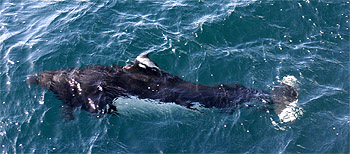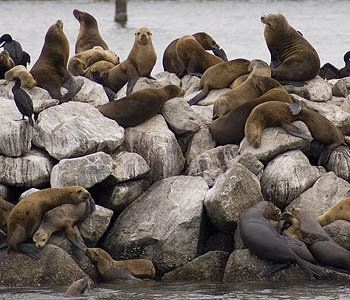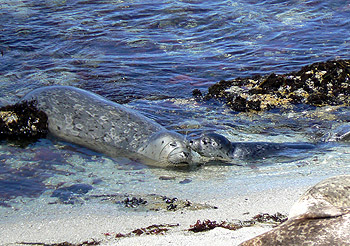
|
|||||||||||||||
|
| |||||||||||||||
Overview May is a time of reproduction and/or migration for many marine mammals. Those that have already given birth are heading northward toward their summer feeding areas. During May dense schools of small fishes, squid, and krill appear along the Central Coast. This rich food source attracts a wide variety of marine mammals that migrate northward along the coast, following the spring bloom. These migrating mammals include humpback whales, blue whales, Dall's porpoise, harbor porpoise, and California sea lions. Other marine mammals, such as gray whales, migrate past the Central Coast on their way toward summer feeding areas farther north. Many seals and sea lions give birth in spring. By May, most adult California sea lions have left the Central Coast to give birth and mate in Southern California. Steller sea lions, on the other hand, are just arriving on the Central Coast, where they will give birth on offshore islands. Harbor seals stay in the Central Coast all year, and will have already given birth on secluded Central Coast beaches. By May, they are teaching their young to hunt food in the shallow waters near shore. Whales migrate north or hunt for food By May, you may be able to see a variety of different whales in Central Coast waters. The last female gray whales and their calves are heading northward from Baja California toward the Bering Sea, and trying to avoid orcas as they cross Monterey Canyon. This dangerous passage is described in greater detail in April. As gray whales become less common along the Central Coast, Humpback whales become more numerous. Note: Humpbacks, sea lions, and porpoises all migrate northward along the California coast in May, following schools of anchovies and sardines up from Southern California. Both predators and prey typically arrive on the Central Coast around May. Some will stay locally to feed. Others will follow the food as far north as British Columbia. The humpbacks may also feed on juvenile krill, which have grown to about half and inch long by May. The first blue whales of the year may also show up in May. Like the humpbacks, the blue whales are migrating northward from Central America, seeking dense swarms of krill. A few minke whales can also be seen in the Monterey Bay and Gulf of the Farallones in May, but they are relatively rare. Dall's and harbor porpoise arrive  A Dall's porpoise resting at the sea surface. Most of the time, Dall's porpoise swim so fast that all you can see is a burst of spray from their tails. (Source: Chad King / SIMoN NOAA ) One of the many marine mammals that take advantage of the increasing food supply in spring is the Dall's porpoise (Phocoenoides dalli). During spring, Dall's porpoise feed on spawning market squid, as well as the occasional anchovy and sardine. As the season progresses, the Dall's porpoise expand their diet to include juvenile rockfish, herring, hake and other deep-water fishes. Dall's porpoise are most common on the Central Coast during the spring upwelling season. They seem to prefer the cold water that accompanies upwelling. They typically leave the Central Coast in fall, just as the water is warming up and white-sided dolphins (a warm-water species) arrive. You can sometimes identify Dall's porpoise by the distinctive white rooster-tails of spray they kick up as they swim rapidly through the water, hunting prey. If you can get close or have good binoculars, you may be able to make out their blunt heads and dark black bodies as well as the striking white patches on their sides. Sometimes the tips of their dorsal fins are also light colored. Dall's porpoise are generally a little smaller than most other dolphins on the Central Coast, growing to about seven feet long and 450 pounds. Harbor porpoise (Phocoena phocoena) also become more abundant in late spring, but do not reach peak abundance until July. Like Dall's porpoise, harbor porpoise are relatively small, but rarely leap or splash at the sea surface. However, they sometimes remain motionless at the surface, as if looking around. Although researchers do not know exactly when and where Dall's and harbor porpoises give birth, young porpoises can occasionally be seen along the Central Coast in July. California sea lions reach peak numbers  A crowd of young sea lions lounge on the breakwater at Moss Landing Harbor. (Source: Kim Fulton-Bennett) Just as schools of market squid and anchovies congregate along certain parts of the Central Coast, so do California sea lions. Most of these are young males. By May, most of the adult male sea lions have left the Central coast, and are busy competing for females on the islands offshore of Southern and Baja California. Large numbers of juvenile and young adult male sea lions apparently migrate northward from Southern California in late winter and early spring, perhaps following the market squid and anchovies. These young male sea lions often reach peak numbers in Central California during May, after the adult males have left. During the day time, sea lions like to congregate at haul-out spots close to sources of food, such as market-squid spawning beds or estuaries. Monterey Harbor, Moss landing Harbor, and San Francisco's Pier 39 all seem to fit the bill quite nicely. At Monterey Harbor, the sea lions apparently come to chow down on market squid that spawn on nearby sand flats. At Moss Landing, the sea lions may feed on anchovies and other small fish that gather near the entrance to Elkhorn Slough. In San Francisco Bay, sea lions are drawn by schools of anchovies that spawn inside the bay in May or June. In May 1996, huge numbers of sea lions took up residence in Monterey Harbor and at San Francisco's Pier 39. Protected by law from harassment, the sea lions hauled out on docks and on small boats, often causing damage and leaving piles of smelly sea-lion poop. San Francisco residents simply turned the occupied docks into a tourist attraction. Monterey citizens, however, were so incensed that they petitioned their congressman to fund a federal study of the problem. At Moss Landing, federal funds were used to build a new floating dock near the harbor entrance in 2007. Within a matter of months, hundreds of sea lions had colonized the dock, causing it to sink. Though the number of sea lions in all three harbors varies considerably from year to year, with sea lion populations increasing along the Central Coast, the problem is not likely to go away any time soon. Sea lions typically rest during the day, hauled out on rocks, docks, or floating buoys. Their peak napping time seems to be mid afternoon. Around twilight, however, the sea lions leave their haul-out areas and head out to sea, looking for food. At this time of day, it is not uncommon to see groups of ten to twenty juvenile sea lions swimming rapidly and porpoising exuberantly as they head out to feeding areas. Sea lions may travel dozens of miles in an evening to reach their favored feeding areas, such as the market-squid spawning beds in Monterey Bay. On nights when market squid aren't spawning, the sea lions eat hake, anchovy, sole, jack mackerel, rockfish, and plainfin midshipman. Most of these fishes form dense schools, making them easy prey for the fast, agile juvenile sea lions. The sea lions typically forage all night and return to their haul-out spots the following morning to rest. Steller sea lions arrive at breeding areas While the Central Coast may be the northernmost breeding area for California sea lions (and a marginal one at that), it is also the southernmost breeding area for a much larger pinniped--the Steller sea lion. In late April or early May, Steller sea lions gather on the wave-swept rocks around Ano Nuevo Island and the Farallon Islands. Huge, chestnut-colored males arrive first and fight for territory, breeding space, and females. The females arrive in mid-May. In June the females will give birth to young conceived during the previous year's mating season. Steller sea lions are coastal animals that do most of their hunting within five miles of shore. They feed on a wide variety of prey, including hake, salmon, herring, squid and octopus, skates, and smelts. Like harbor seals, they seldom actually come ashore, but often sun themselves on offshore islands, reefs, and isolated ledges. Like California sea lions, Stellar sea lions were once quite common on the Central California coast, but they were savagely hunted for their skins in the 1800s. Even in the 20th century fishermen routinely shot Stellar sea lions and dynamited their rookeries, until the passage of the Marine Mammal Protection Act (MMPA) in 1972. Unlike California sea lions, Stellar sea lion numbers off California only increased slightly after the passage of the MMPA. In 1990 they were listed as threatened under the US Endangered Species Act. However in 2013 the sub-population from Central Alaska to California was removed from the list, mostly because populations were increasing in Alaska and Oregon. Off California the number of pups born each year has increased since 1990 even though the number of adults at breeding sites has not. Female elephant seals return to rookeries to moult By May, the elephant-seal rookeries on Ano Nuevo island and along the Big Sur coast are pretty quiet. Most of the young elephant seals have left the area to try to find food in the open waters of the north Pacific. However, you may see a few young seals who haven't left yet, as well as adult females who are have returned to shore for their annual moult. Most of these adult female elephant seals have spent the last two months foraging for squid and bottom fish such as hake, in the deep waters of the North Pacific. This feeding trip is essential because the females have been fasting for the previous four months, as they give birth and nurse their pups. Most mammals shed their hair (moult) more or less continuously. Elephant seals, on the other hand undergo what is called a "catastrophic moult," losing all of their hair over just a few weeks. During this time, the normally streamlined animals look positively mangy. Worse yet, they cannot dive into the depths to hunt prey. All they can do is lounge on the shore, conserve their energy, and wait it out. Although the adult females are just starting to arrive at Ano Nuevo to moult in May, some juvenile elephant seals (both male and female) will already have come ashore to moult in April or May. These year-old juveniles are much smaller than the adult females (about six feet long) and have golden fur. The newly arrived adult females have darker fur and are much larger—about eight feet from nose to tail. In June, the female elephant seals will head back out to sea, spending the next seven months foraging in the Gulf of Alaska. But the molting areas will not remain empty for long. Just as the females leave, a wave of adolescent males will come ashore to moult at Ano. Adult males will use the same beaches for molting in June or July. Harbor seals raise young  A female harbor seal pup nuzzles its mother after swimming with her in the shallow waters near shore. (Source: Kim Fulton-Bennett) Although most harbor seal pups are born in April, the pupping beaches are still very busy and exciting places to visit in May. If the weather is nice, young pups will be swimming around the protected waters near shore and exploring their surroundings, returning frequently to the beach to nurse. They must also learn from their mothers how to forage for food. At four to six weeks old, the pups will spend less time nursing and more time on their own. One May afternoon at the harbor-seal nursery beach in Pacific Grove, I saw a harbor seal pup floating motionless, face down in the water, just off the beach. An adult female seal (presumably its mother) swam slowly in circles around the pup, and occasionally dove underneath it. At first I thought the pup was dead. But after what seemed like five or ten minutes, the pup poked up its head and began swimming around. Later I saw other pairs of mothers and pups go through a similar process. Apparently the pups were practicing holding their breath while watching their mothers forage for food on the shallow seafloor below. Female harbor seals change the types of food they eat at this time of year, as some types of prey become scarce and others become more available. From February to April, before and soon after they give birth, female harbor seals hunt for market squid and octopus, as well as a few bottom fish such as sand dabs and sole (which are just moving back into shallow water in spring). In May, however, the nursing females switch to eating the juvenile rockfish that are just settling down around the kelp beds. They also eat plainfin midshipman, which come into shallow water to breed in spring. Female harbor seals that give birth in San Francisco Bay typically eat lots of juvenile anchovies. After pupping season, you can often see both juvenile and adult harbor seals hanging out at sheltered haul-out sites, usually within a few feet of the water's edge. They prefer inaccessible offshore rocks or remote spots that are protected from wind and wave action (several sand bars in Elkhorn Slough are very popular). After spending most of the day resting, they will slip into the water in late afternoon or early evening to head out for an evening of foraging. |
